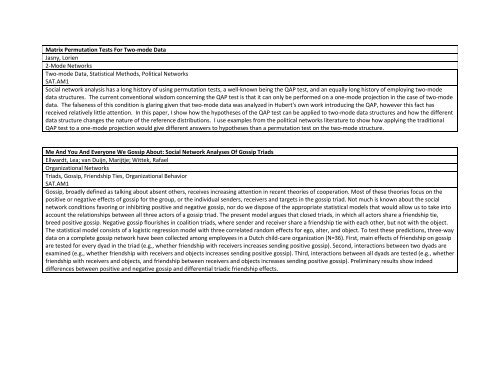Sunbelt XXXI International Network for Social Network ... - INSNA
Sunbelt XXXI International Network for Social Network ... - INSNA
Sunbelt XXXI International Network for Social Network ... - INSNA
Create successful ePaper yourself
Turn your PDF publications into a flip-book with our unique Google optimized e-Paper software.
Matrix Permutation Tests For Two‐mode DataJasny, Lorien2‐Mode <strong>Network</strong>sTwo‐mode Data, Statistical Methods, Political <strong>Network</strong>sSAT.AM1<strong>Social</strong> network analysis has a long history of using permutation tests, a well‐known being the QAP test, and an equally long history of employing two‐modedata structures. The current conventional wisdom concerning the QAP test is that it can only be per<strong>for</strong>med on a one‐mode projection in the case of two‐modedata. The falseness of this condition is glaring given that two‐mode data was analyzed in Hubert's own work introducing the QAP, however this fact hasreceived relatively little attention. In this paper, I show how the hypotheses of the QAP test can be applied to two‐mode data structures and how the differentdata structure changes the nature of the reference distributions. I use examples from the political networks literature to show how applying the traditionalQAP test to a one‐mode projection would give different answers to hypotheses than a permutation test on the two‐mode structure.Me And You And Everyone We Gossip About: <strong>Social</strong> <strong>Network</strong> Analyses Of Gossip TriadsEllwardt, Lea; van Duijn, Marijtje; Wittek, RafaelOrganizational <strong>Network</strong>sTriads, Gossip, Friendship Ties, Organizational BehaviorSAT.AM1Gossip, broadly defined as talking about absent others, receives increasing attention in recent theories of cooperation. Most of these theories focus on thepositive or negative effects of gossip <strong>for</strong> the group, or the individual senders, receivers and targets in the gossip triad. Not much is known about the socialnetwork conditions favoring or inhibiting positive and negative gossip, nor do we dispose of the appropriate statistical models that would allow us to take intoaccount the relationships between all three actors of a gossip triad. The present model argues that closed triads, in which all actors share a friendship tie,breed positive gossip. Negative gossip flourishes in coalition triads, where sender and receiver share a friendship tie with each other, but not with the object.The statistical model consists of a logistic regression model with three correlated random effects <strong>for</strong> ego, alter, and object. To test these predictions, three‐waydata on a complete gossip network have been collected among employees in a Dutch child‐care organization (N=36). First, main effects of friendship on gossipare tested <strong>for</strong> every dyad in the triad (e.g., whether friendship with receivers increases sending positive gossip). Second, interactions between two dyads areexamined (e.g., whether friendship with receivers and objects increases sending positive gossip). Third, interactions between all dyads are tested (e.g., whetherfriendship with receivers and objects, and friendship between receivers and objects increases sending positive gossip). Preliminary results show indeeddifferences between positive and negative gossip and differential triadic friendship effects.
















